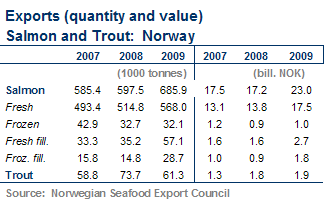Salmon - May 2010
.jpg)
The market for farmed Atlantic salmon is becoming extremely tight with prices reaching record levels in all markets. Supply from Chile is at an historic low whereas Norway’s 2010 production is negatively impacted by a harsh winter and slow growth.
Supplies extremely low due to harsh winter in Norway and diseases in Chile
The market for farmed Atlantic salmon is becoming extremely tight with prices reaching record levels in all markets. Supply from Chile is at an historic low whereas Norway’s 2010 production is negatively impacted by a harsh winter and slow growth. The high prices are creating problems for processors in particular but retailers are also looking for alternatives, including Coho salmon and trout. The situation is expected to remain tight at least until the new Norwegian production comes to market during the summer months, but for any significant increase in supply, buyers will have to wait until Chile has overcome its production problems, which is unlikely to be before 2011 or 2012.
 Norway: a harsh winter causes late harvests
Norway: a harsh winter causes late harvests
Norway, the largest producer and exporter of salmon, has been the main benefiter of Chile’s production problems, although the many Norwegian producers operating in Chile have also been hurt by the same problems. And with production problems now in Norway as well, Norway’s total output for 2010 looks set to be below 2009 levels. The reason behind Norway’s surprising fall in output is twofold, one is the impact of sea lice, which has hurt a number of producers, and the other is an exceedingly harsh Norwegian winter causing water temperatures to remain much lower than normal, effectively impeding salmon growth rates. As a result, the 2010 Norwegian harvest is late resulting in markets being undersupplied. The situation will improve from June onwards as the new generation reaches market size. Norway’s 2009 production and exports setnew records with export volumes up 15% but values jumping a massive 33% from 2008. The fillet market in particular was especially good as Norwegian producers rushed to fill the gap in the US market created by the shortfall in Chile’s supply. 71% of Norway’s export volumes and 70% of values are to the EU with France, Poland, Denmark and the UK as the largest destinations. Non-EU markets such as Russia, the USA and Japan all showed growth in imports from Norway, mainly thanks to the shortfall in Chilean supply. Export growth to the US in particular was impressive with 300% increases from 2008.
 France: appetite for salmon without limits?
France: appetite for salmon without limits?
The French economy has proven resilient during the economic downturn and so has its consumption of salmon. In fact, French salmon imports in 2009 bounced a massive 18% surpassing 150 000 tonnes for the first time. Strongest growth was registered in the segments for fresh whole salmon and fresh fillets. Smoked salmon imports are also growing, partly as a result of the wholesale move of the European smoking industry to Poland, including much of France’s own smoking capacity. Salmon is firmly entrenched in French seafood consumption with penetration in all market segments. At present price levels though, many of the more price conscious segments are showing resistance with buyers looking for cheaper alternatives. This includes retail chains that have started looking at Coho and some mass market restaurants are substituting salmon with less costly seafood species.
Germany: strong import growth in 2009
2009 was an excellent year for salmon in Germany with imports setting new records at almost 125 000 tonnes. Smoked salmon imports in particular were strong with annual growth in volumes close to 50%. The main reason for this is the outsourcing of most of Germany’s smoked salmon industry to Poland, including the takeover of local smokehouse Lascinger by Polish Morpol. Germany remains however a very price conscious market and at present price levels, consumption of salmon will remain flat in the coming year.
Difficulties due to flight interruption The ongoing eruption of the Icelandic volcano is also making its impact felt in world salmon markets. The cancellation of flights to the USA, have made more volumes available to European consumers with a downward pressure on prices. As a consequence, prices in the US should be trading higher until the situation returns to normal.

